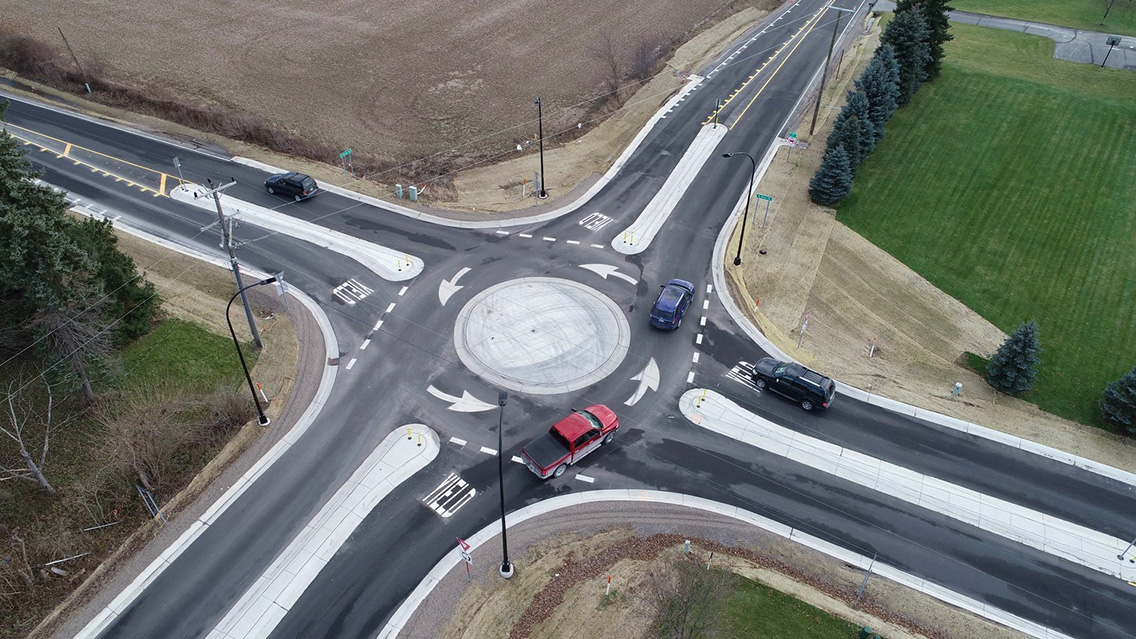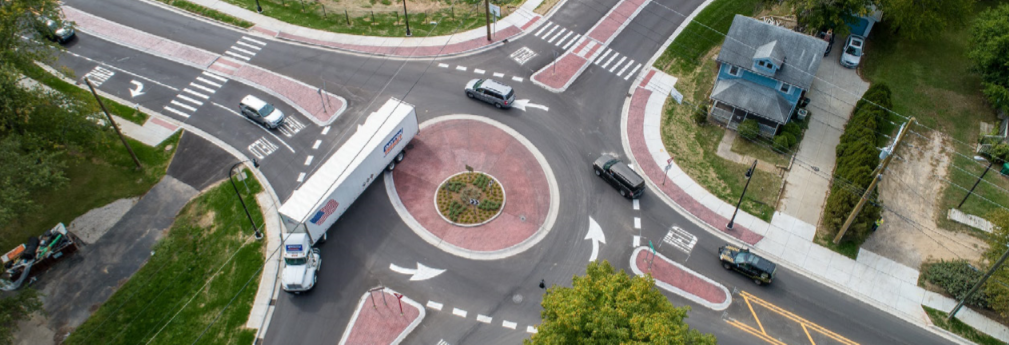Pilot installations of compact and mini-roundabouts throughout the United States are showing promising results, offering safety-conscious, cost-effective solutions for replacing less efficient all-way and stop-controlled intersections. These smaller roundabouts are already fairly common across the United Kingdom and Europe and emerging in the United States as the preferred intersection for communities with lower volume and physically-constrained locations.

Mini-roundabout at the intersection of Moon Road and Bemis Road in Saline, Michigan.
What are mini- and compact roundabouts?
Mini-roundabouts generally have an inscribed circular diameter of 45 to 80 feet, with traversable center or splitter islands. They are generally used where the existing speed limit is 25 mph or less and in urban, suburban and smaller municipal environments. They’re generally not suited for high-volume use (15,000 or greater average daily traffic) such as on state routes and major highways. The mini-roundabouts are generally not recommended for intersections with more than four legs, but if necessary, two mini-roundabouts can be designed and placed close together to accommodate situations with multi-legged traffic.
Compact roundabouts generally have an internal circular diameter of 70 to 110 feet and contain a hybrid of attributes found in both mini- and single-lane roundabouts. Similar to a mini-roundabout, a compact roundabout requires minimal additional pavement space, and may have a completely mountable center island which can accommodate the wider turning radii of large trucks without requiring a larger overall size.

Both designs offer similar benefits of efficiency, traffic calming and enhanced safety as larger roundabouts – with the added benefit of having a smaller footprint. As a result, it is uncommon for municipalities to need to purchase extra right-of-way for their installation. In many cases, they fit within the footprint of the existing traditional intersection. Mini- and compact roundabouts are best suited to environments where speeds are already low and environmental constraints would preclude the use of a larger roundabout with a fixed, raised central island. They operate in the same manner as single- and multi-lane roundabouts, with yield control on all entries and counterclockwise circulation around a relatively flat central island.
Enhanced safety and efficiency
Like their larger counterparts, what makes mini- and compact roundabouts safe is their ability to reduce vehicle speed and avert collisions due to single-directional travel. They reduce the dominance of one line of traffic flow by prioritizing and yielding to circulating traffic from the left. Both have been used successfully in the U.K. to improve safety at intersections with documented collision reports, with successful crash rate reductions of approximately 30 percent. In addition, research sponsored by the Federal Highway Administration (FHWA) in the U.S. indicates that roundabouts are improving safety statistics compared to many signalized or all-way, stop-controlled (AWSC) intersections where serious collisions like T-bones are more common.
Roundabouts of all sizes are also more efficient. They support a higher capacity of traffic than AWSC because they can service two to three vehicles at any time – with flexibility in coping with variations in both volumes and proportions of traffic flow during all times of the day. There is also less waiting time for movement, allowing for a more fluid, responsive and timely intersection experience. The result? Reduced delay, reduced fuel consumption and reduced vehicle emissions.
Cost effective, low maintenance
There are some notable cost savings related to the installation of a mini- or compact roundabout, not to mention savings related to time, materials and long-term maintenance. At the forefront, municipalities save on the cost of property and real estate acquisition. Because these smaller intersections require less physical operational space, there is generally little need to purchase additional right-of-way. This translates to fewer impacts to adjacent property owners, and fewer materials needed for construction, which also makes the project faster to construct.
The cost of constructing a mini- or compact roundabout varies. Incorporating both design and construction, one can estimate somewhere between $100,000 – $800,000 per intersection, with retrofits reported between $65,000 and $600,000, depending on materials and size. However, this is still significantly lower than the average full roundabout cost, generally about one-third to half of the cost.

A mini-roundabout accommodates large truck patterns at the intersection of Baker Road and Dan Hoey Road in Dexter, Michigan. Image courtesy of Mark McCulloch, WCRC.
Small stature, large impact
Compact and mini-roundabouts are gaining traction worldwide, especially as population density increases, traffic levels rise and space becomes less available. They may be smaller in stature, but no doubt, they are making a large impact when it comes to improving intersection ergonomics and reducing transportation collisions.
Ready to learn more? Connect with our roundabout and transportation experts to start solving your community’s intersection challenges.
